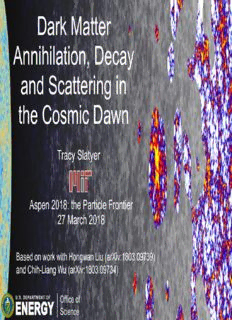
Dark Matter Annihilation, Decay and Scattering in the Cosmic Dawn PDF
Preview Dark Matter Annihilation, Decay and Scattering in the Cosmic Dawn
Dark Matter Annihilation, Decay and Scattering in the Cosmic Dawn Tracy Slatyer Aspen 2018: the Particle Frontier 27 March 2018 Based on work with Hongwan Liu (arXiv:1803.09739) and Chih-Liang Wu (arXiv:1803.09734) Outline Background: 21cm observations Claimed observation of an absorption trough by EDGES Possible interpretations Tests of DM-scattering interpretations What we can learn about DM annihilation/decay Parametrics of a 21cm signal Spin-flip transition of neutral hydrogen can be used to probe temperature and distribution of the neutral gas in the early universe prior to reionization (z > 7 or so). 21cm absorption/emission signal strength depends on “spin temperature” T , measure of S #H in ground vs excited state - expected to lie between gas temperature T and CMB gas temperature T . CMB Absorption signal when T < T (radiation temperature), emission signal if T > T . S R S R T here describes # photons at 21cm wavelength - not necessarily thermally distributed. R Expected behavior: T decouples from T around redshift z~150, subsequently satisfies gas CMB T ~ T (1+z)/(1+z) . Gas is later heated by the stars, and eventually T increases gas CMB dec gas above T . Thus expect early absorption, later emission. CMB reionization emission absorption Valdes et al, MNRAS 429, 1705-1716 (2013) 21cm signals Poulin et al JCAP03(2017)043 from decay/ annihilation Dark matter decay or annihilation can produce secondary particles that can heat the gas (also produce extra ionization, extra photons, etc). Lopez-Honorez et al JCAP08(2016)004 Can serve as an early source of heating, causing 21cm emission (not absorption) at unexpectedly early times (z~20-25 for decaying DM). Annihilation case more challenging, but (at least for some DM masses) could potentially leave unique signatures. A measurement of 21cm absorption in the dark ages? The Experiment to Detect the Global Epoch-of-reionization Signature (EDGES) has claimed a detection of the first 21cm signal from the cosmic dark ages [Bowman et al, Nature, March ’18] Claim is a deep absorption trough corresponding to z~15-20 - implies spin temperature < CMB temperature. Measurement of T /T (z=17.2) < gas R T /T < 0.105 (99% confidence). S R Interpreting EDGES If T is taken to be the CMB temperature, this gives T < 5.2 K R gas But assuming standard decoupling and no stellar heating, we can calculate T ~ gas 7 K. It is quite possible this result is spurious - e.g. due to instrumental effects and/or foregrounds. But if it is confirmed, suggests either T > T (new radiation backgrounds) R CMB [Feng & Holder 1802.07432], or some modification to the standard scenario that lowers T . gas New radiation backgrounds could arise from either novel astrophysics, i.e. radio emission from early black holes [Ewall-Wice et al 1803.01815] or more exotic (DM-related?) sources [Fraser et al 1803.03245, Pospelov et al 1803.07048]. Additional cooling of the gas could be due to modified recombination history (earlier decoupling from CMB), or scattering of the gas on a colder bath, e.g. (some fraction of) the dark matter [e.g. Barkana, Nature, March ’18; Munoz & Loeb 1802.10094; Berlin et al 1803.02804; Barkana et al 1803.03091] DM scattering as an explanation for EDGES DM-baryon scattering can cool down the ordinary matter [e.g. Munoz et al ’15] But strong DM-baryon interactions also disrupt CMB perturbations! [Dvorkin et al ’13, Gluscevic et al ’17, Boddy et al ’18, Xu et al ’18]. If an O(1) fraction of DM scatters with baryons, need scattering to be enhanced at late times to avoid CMB Example troughs from limits. DM/baryon scattering [Barkana] Late times = low thermal velocities - consider models where cross section scales like v-4 (Rutherford scattering) DM-baryon scattering in the early universe [TRS & Wu 1803.09734] σ~v-4 scaling can cool the gas enough to accommodate the EDGES observation for sub- GeV DM masses, without violating CMB bounds [note: v1 of 1802.06788 suggested otherwise; v2 (to post tonight) revises the limit, now matches our result.] Substantially weaker velocity scalings (in particular, σ~v-2) are not sufficient under standard assumptions. Constraint dominantly comes from z~103-few x 104 - suppressing signal at these redshifts would work as well as velocity dependence. If the DM is cold enough, problem is approximately linear - in this case, our paper provides a basis set of functions that can be used to estimate the Planck constraints on arbitrary redshift-dependent scattering within this period. Probing millicharged dark matter Several authors [e.g. Munoz et al ’18, Berlin et al ’18, Barkana et al ‘18] have suggested that if ~1% of (10-100 MeV) DM carries a tiny electric charge, this could explain the signal. Evade CMB-anisotropy constraints TRS & Wu, 1803.09734 because bulk of DM is not interacting - perturbations (probably) OK. But early DM-baryon interactions (cooling the gas) could distort CMB blackbody spectrum [Ali-Haimoud et al ‘2015] - depends on energy flow from baryons to DM, like EDGES, not on gravitational effects. TRS & Wu 1803.09734: extending these limits to case with millicharge, next- gen experiment PIXIE could test this parameter space. Testing DM annihilation/ decay with 21cm If we can constrain the gas temperature at z~17 at a similar level of precision to the EDGES claim, what can we learn about DM annihilation/decay? We said it predicts early emission - clearly not what is seen at the moment! What are the constraints? Calibration: for light DM decaying to electrons, competitive current constraints come from requiring that DM not overheat the universe - by 10,000K at redshift ~6! [Liu, TRS & Zavala 2016, PRD 94, 063507]
Description: